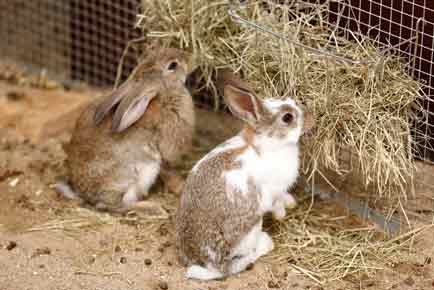Hay Feeding Strategies: Balancing Diets for Optimal Animal Health
Feeding livestock is a nuanced task that demands thoughtful planning and consideration. Among the key constituents of many livestock diets, hay stands out as a valuable source of fiber, energy, and essential nutrients. Properly managing hay feeding is of utmost importance in securing the health and productivity of animals. We’ll explore hay feeding strategies and underscore the significance of dietary equilibrium in meeting the nutritional prerequisites of your livestocks hay diet meal plan.

(Two little rabbits at meal eating hay.)
Comprehending Hay's Role in Livestock Diets
Hay constitutes a fundamental element in the diets of a broad spectrum of livestock species, including cattle, horses, sheep, goats, and rabbits. Its primary function is to offer fiber, which is indispensable for facilitating proper digestion and maintaining overall gastrointestinal health in herbivorous animals.
Apart from fiber, hay diet benefits animals with varying quantities of energy, protein, vitamins, and minerals contingent upon the type and quality of hay in question. To fashion a well-rounded diet for your animals, it’s critical to grasp the nutritional composition of the hay you’re providing. Winter feeding strategies can help you during harsh climate conditions to keep your animals with the proper food they need, not too much and not enough.
Diverse Hay Varieties
Several types of hay are available, each possessing its unique nutritional attributes. The choice of hay type hinges on factors such as the species of livestock, their age and life stage, and their specific dietary requisites. Here are some prevalent hay types:
- Grass Hay: This category includes hay types such as timothy, bermuda grass, and orchard grass. Grass hay generally boasts lower protein and energy content than legume hays, rendering it a fitting option for mature, non-lactating animals.
- Legume Hay: Alfalfa, clover, and peanut hay fall under the legume hay category. Characterized by higher protein and energy levels compared to grass hay, legume hay proves ideal for young and growing animals, pregnant or lactating females, and those with elevated energy demands. Alfalfa and hay diet for horses for weight gain has been proven quite successful
- Mixed Hay: Mixed hay amalgamates grasses and legumes, providing a harmonized nutritional profile. This versatile option can serve a plethora of livestock species, delivering a blend of fiber, protein, and energy.
- Timothy Hay: Timothy hay enjoys popularity among small animals like rabbits and guinea pigs due to its elevated fiber content and moderate protein levels. It is also a suitable choice for adult horses, cattle, and sheep.
- Orchard Grass Hay: Orchard grass hay, akin to timothy hay in terms of nutrition, caters to a spectrum of livestock species.
Striking a Dietary Balance with Hay
Balancing livestock diets involves carefully selecting hay and other components to meet their specific nutritional requirements. Factors such as species and life stage play a crucial role; understanding whether animals are growing, reproducing, or maintaining is essential. Exceptions to hay diets include young, pregnant, or nursing animals, as well as those with dental or health issues. Evaluating hay quality is paramount, ensuring it is fresh, mold-free, and nutritionally balanced, often aided by hay testing. Considering animals’ energy needs is vital, with younger or working animals requiring more energy than mature, non-lactating ones. Protein requirements vary by species and life stage, necessitating hay that aligns with these needs. Additionally, hay may not provide all necessary minerals and vitamins, requiring deliberate supplementation. Fiber is critical for digestive health, emphasizing the importance of adequate fiber intake. When diet formulation becomes complex, consulting a livestock nutritionist can provide tailored solutions to meet animals’ nutritional needs efficiently.
Effective Feeding Management
Competent feeding management is pivotal in guaranteeing that animals receive the appropriate quantity of hay and supplementary feed. The following feeding strategies warrant attention:
- Free-Choice Feeding: Forage should be accessible to animals at their discretion, permitting them to consume it as per their requirements. This approach proves especially pivotal for ruminants like cattle and sheep that mandate uninterrupted access to forage for sustaining proper digestive function.
- Limit Feeding: In specific scenarios, limiting hay consumption may be obligatory to avert obesity or address particular health issues. Consultation with a veterinarian or nutritionist can proffer guidance concerning limit feeding.
- Averting Overindulgence or Underfeeding: Offering an excess or insufficiency of hay can instigate issues like wastage and weight anomalies in animals. The utilization of feeders or racks serves to curb hay contamination and ensure judicious consumption.
- Routine Body Condition Evaluation: Regular assessment of animals’ body condition is paramount. Adjusting their diet as necessitated by evolving circumstances is integral in sustaining an ideal body condition score.
- Gradual Transitioning: When introducing fresh hay varieties or implementing dietary alterations, a gradual transition is prudent to stave off digestive distress.
Fiber's Crucial Role in the Diet
Fiber plays a critical role in hay, supporting the digestive health of herbivorous animals in several key ways. Firstly, fiber undergoes fermentation in the digestive system, facilitated by beneficial microorganisms, producing volatile fatty acids (VFAs) that serve as an energy source and contribute to a healthy gut environment. Additionally, fiber helps prevent digestive disorders such as colic in horses or bloat in ruminants by regulating food transit through the digestive tract and preventing blockages. Moreover, fiber helps animals regulate their appetite by providing a sensation of fullness, which helps prevent overeating. Furthermore, fiber aids in the absorption of nutrients in the digestive tract by delaying digestion, leading to enhanced nutrient utilization. This comprehensive understanding of fiber’s importance underscores its value in promoting overall animal health and well-being.
Common Hay Feeding Pitfalls to Avoid
In navigating the crucial role of hay in livestock diets, it’s essential to avoid common pitfalls that may compromise animal health and well-being. Firstly, inferior hay quality can lead to nutrient deficiencies, emphasizing the importance of investing in high-quality hay or conducting nutrient testing for accurate assessment. Additionally, overfeeding or underfeeding hay quantities can result in weight management complications, highlighting the need to tailor hay amounts to meet animals’ specific needs. Furthermore, neglecting nutritional balance in diets can have detrimental effects, underscoring the importance of considering protein, energy, and nutrient requirements. Finally, overlooking the significance of fiber can contribute to digestive issues, emphasizing the necessity of ensuring animals receive sufficient fiber for effective digestive function. By addressing these key considerations, livestock owners can optimize their feeding practices and promote the health and vitality of their animals.
In Conclusion
Hay constitutes a cornerstone in livestock diets, delivering fiber, energy, and essential nutrients. Prudent hay feeding is pivotal for nurturing optimal animal health and productivity. The pursuit of dietary equilibrium is contingent on species, life stage, hay quality, and nutritional requisites. Additionally, judicious feeding management practices, coupled with an appreciation of fiber’s indispensability in the diet, contribute to the overall well-being of your livestock. By meticulously considering these facets and circumventing common feeding errors, you can guarantee that your animals acquire the nourishment essential for optimal health and performance.

